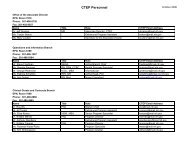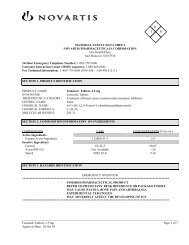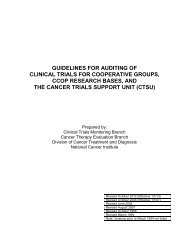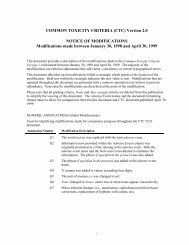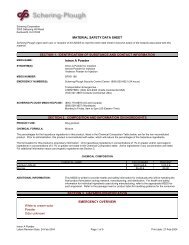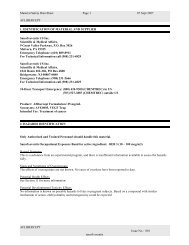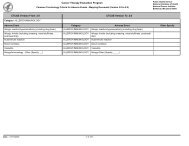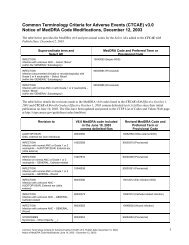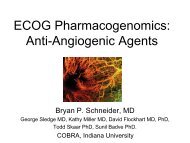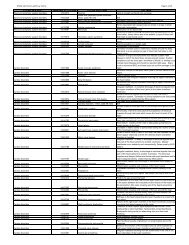ctep, nci guidelines: adverse event reporting requirements - Cancer ...
ctep, nci guidelines: adverse event reporting requirements - Cancer ...
ctep, nci guidelines: adverse event reporting requirements - Cancer ...
You also want an ePaper? Increase the reach of your titles
YUMPU automatically turns print PDFs into web optimized ePapers that Google loves.
CTEP, NCI GUIDELINES: ADVERSE<br />
EVENT REPORTING<br />
REQUIREMENTS<br />
Effective January 1, 2005<br />
AdEERS Technical Help Desk<br />
Phone: 888-CTEPHLP (1-888-283-7457)<br />
Fax: 301.948.2242<br />
E-mail: <strong>nci</strong><strong>ctep</strong>help@<strong>ctep</strong>.<strong>nci</strong>.nih.gov<br />
AdEERS Content Help Desk<br />
Phone: 301.897.7497<br />
Fax: 301.230.0159<br />
E-mail : adeersmd@tech-res.com
RECORD OF CHANGES<br />
Update Date Brief Description<br />
12/15/04 Initial Document Creation<br />
12/29/04<br />
1/3/05<br />
1/17/05<br />
Minor editorial revisions include removing the word ‘Expedited’ from the<br />
document’s title and adding the NCI CTEP Help Desk toll-free phone number.<br />
PDF conversion process correction to provide legible process flow in Attachment<br />
A (pg 15).<br />
Corrected date in Record of Changes. Replaced Attachment A illustration for<br />
accurate PDF conversion.<br />
6/30/06 Revised the cover date to read ‘Effective January 1, 2005’.
Table of Contents<br />
Record of Changes........................................................................................................................................ 2<br />
1 INTRODUCTION................................................................................................................................. 1<br />
1.1 Purpose ............................................................................................................................................ 1<br />
1.2 Investigator Responsibility - Adverse Event Documentation and Reporting ................................... 1<br />
1.2.1 Distribution of Expedited Reports for Agents under a CTEP IND ........................................... 2<br />
1.2.2 Distribution of Expedited Reports for non-CTEP IND Agents................................................. 2<br />
2 DEFINITIONS ...................................................................................................................................... 3<br />
2.1 Adverse Event (AE) .......................................................................................................................... 3<br />
2.2 Toxicity............................................................................................................................................. 3<br />
2.3 Serious Adverse Event (SAE) ........................................................................................................... 3<br />
2.4 Severity............................................................................................................................................. 3<br />
2.5 Life-Threatening Adverse Event....................................................................................................... 3<br />
2.6 Common Toxicity Criteria Version 2.0 (CTC) and Common Terminology Criteria for Adverse<br />
Events V3.0 (CTCAE)....................................................................................................................... 4<br />
2.7 Grade ............................................................................................................................................... 4<br />
2.8 Unexpected/Expected Adverse Events..............................................................................................4<br />
2.8.1 Comprehensive Adverse Event and Potential Risks (CAEPR)................................................. 4<br />
2.8.2 Agent Specific Adverse Event List (ASAEL)........................................................................... 5<br />
2.8.3 Expected Adverse Event (for Expedited Reporting Purposes for Agents under a CTEP IND) 5<br />
2.8.4 Expected Adverse Event (for Expedited Reporting Purposes for non-CTEP IND Agents)...... 5<br />
2.8.5 Unexpected Adverse Event (for Expedited Reporting Purposes for Agents under a CTEP<br />
IND).......................................................................................................................................... 5<br />
2.8.6 Unexpected Adverse Event (for Expedited Reporting Purposes for non-CTEP IND Agents).. 5<br />
2.9 Attribution ........................................................................................................................................ 5<br />
2.10 Commercial Agent............................................................................................................................ 6<br />
2.11 Investigational Agent ....................................................................................................................... 6<br />
2.12 Secondary Malignancy..................................................................................................................... 6<br />
2.13 Second <strong>Cancer</strong> ................................................................................................................................. 6<br />
3 CTEP, NCI ADVERSE EVENT REPORTING GUIDELINES ....................................................... 7<br />
3.1 Routine Adverse Event Reporting..................................................................................................... 7<br />
3.1.1 Clinical Data Update System (CDUS)...................................................................................... 7<br />
3.1.2 Clinical Trials Monitoring System (CTMS) ............................................................................. 7<br />
3.2 Expedited Adverse Event Reporting................................................................................................. 8<br />
3.2.1 Adverse Event Expedited Reporting System (AdEERS) .......................................................... 8<br />
3.2.2 Expedited Adverse Event Reporting of Hospitalization or Prolongation of Existing<br />
Hospitalization for all Phases of Trials ..................................................................................... 8<br />
3.2.2.1 24-Hour Notification for CTEP IND Trials..................................................................... 8<br />
3.2.2.2 24-Hour Notification for non-CTEP IND Trials.............................................................. 9<br />
3.3 Routine and Expedited Reporting Requirements for Specialized Adverse Events............................ 9<br />
December 15, 2004 i
3.3.1 Reporting Requirements for Baseline Adverse Events ............................................................. 9<br />
3.3.2 Reporting Requirements for Persistent/Recurring Adverse Events ........................................ 10<br />
3.3.3 Reporting Requirements for Adverse Events experienced in a Clinical Trial utilizing<br />
Investigational Agent(s) and Commercial Agent(s) on Separate Arms under a CTEP IND... 12<br />
3.3.3.1 Routine Reports ............................................................................................................. 12<br />
3.3.3.2 Expedited Reports.......................................................................................................... 12<br />
3.3.4 Reporting Requirements for Adverse Events experienced in a Clinical Trial utilizing<br />
Investigational Agents in combination with Commercial Agent(s) on the same arm............. 12<br />
3.3.4.1 Routine Reports ............................................................................................................. 12<br />
3.3.4.2 Expedited Reports.......................................................................................................... 12<br />
3.4 Trials utilizing an Agent under a CTEP IND: AdEERS Expedited Reporting Requirements for<br />
Adverse Events Based on Phase of Trial........................................................................................ 13<br />
3.4.1 Phase 1 Trials utilizing an Agent under a CTEP IND: AdEERS Expedited Reporting<br />
Requirements for Adverse Events that occur within 30 Days of the Last Dose of the<br />
Investigational Agent .............................................................................................................. 13<br />
3.4.2 Phase 2 and Phase 3 Trials utilizing an Agent under a CTEP IND: AdEERS Expedited<br />
Reporting Requirements for Adverse Events that occur within 30 Days of the Last Dose of the<br />
Investigational Agent .............................................................................................................. 14<br />
3.5 Exceptions for Expedited Reporting............................................................................................... 14<br />
3.5.1 Persistent or Significant Disabilities/Incapacities ................................................................... 14<br />
3.5.2 Death....................................................................................................................................... 14<br />
ATTACHMENT A: THE ADVERSE EVENT REPORTING REQUIREMENT PARADIGM FOR AGENTS UNDER A<br />
CTEP IND ................................................................................................................................................... 15<br />
Tables<br />
Table A: CDUS Guidelines for Routine Adverse Event Reporting on Trials using Agent(s) under a CTEP<br />
IND............................................................................................................................................... 7<br />
Table B: CTMS Guidelines for Routine Adverse Event Reporting for Trials using Agent(s) under a CTEP<br />
IND............................................................................................................................................... 7<br />
Table C: Reporting Requirements for Adverse Events that occur within 30 Days 1 of the Last Dose of the<br />
Investigational Agent on Phase 1 Trials ..................................................................................... 13<br />
Table D: Reporting Requirements for Adverse Events that occur within 30 Days 1 of the Last Dose of the<br />
Investigational Agent on Phase 2 and 3 Trials............................................................................ 14<br />
December 15, 2004 ii
1 INTRODUCTION<br />
CTEP, NCI Guidelines: Adverse Event Reporting Requirements<br />
The Federal Food and Drug Administration (FDA), HHS, defines in the Code of Federal<br />
Regulations (CFR) procedures and <strong>requirements</strong> governing the use of investigational new drugs<br />
and the monitoring of serious <strong>adverse</strong> <strong>event</strong>s (21 CFR 312). The <strong>Cancer</strong> Therapy Evaluation<br />
Program (CTEP), NCI, sponsors an extensive national program of cancer research as both an<br />
Investigational New Drug application (IND) sponsor and/or a funding sponsor and is responsible<br />
for ensuring that the research is conducted in accordance with Federal Regulations.<br />
1.1 Purpose<br />
The purpose of this document from CTEP, NCI, as an IND sponsor, is to:<br />
1. Provide <strong>guidelines</strong> for investigators regarding <strong>adverse</strong> <strong>event</strong> (AE) <strong>reporting</strong> to CTEP for<br />
agents under a CTEP IND;<br />
2. Ensure that investigators submit sufficient information to allow CTEP, Investigational<br />
Drug Branch (IDB) physicians adequate information to make an independent assessment<br />
of AEs that occur on trials utilizing an agent under a CTEP, IND; and<br />
3. Determine if an expedited report to the FDA is warranted and if so, submit the report<br />
within the timeframe stipulated in the CFR.<br />
A second purpose of this document is to explain the expanded use of AdEERS for expedited AE<br />
<strong>reporting</strong> for Cooperative Group trials utilizing commercial agents. All Cooperative Groups must<br />
use AdEERS for:<br />
1. Trials utilizing a commercial agent only;<br />
2. Trials utilizing an investigational agent under a CTEP IND and a commercial agent on<br />
separate arms;<br />
3. Trials utilizing an investigational agent under a CTEP IND and a commercial agent on<br />
the same arm.<br />
1.2 Investigator Responsibility - Adverse Event Documentation<br />
and Reporting<br />
Clinical investigators and ultimately the protocol Pri<strong>nci</strong>pal Investigator (PI) have the primary<br />
responsibility for AE identification, documentation, grading, and assignment of attribution. The<br />
CTEP, NCI Common Toxicity Criteria v2.0 (CTC) and Common Terminology Criteria for<br />
Adverse Events v3.0 (CTCAE) are designed as instruments to be used to document AEs<br />
identified through a combination of clinical and laboratory evaluation. CTC/CTCAE are not tools<br />
to assist with data extraction from source documents without the direct participation and<br />
supervision of clinical investigators. AE grading and assignment of attribution require<br />
documentation by medical personnel who are directly involved in the clinical care of protocol<br />
subjects.<br />
The CTEP, NCI <strong>adverse</strong> <strong>event</strong> <strong>reporting</strong> <strong>requirements</strong> and timing of expedited reports include<br />
established criteria based upon:<br />
Phase of trial<br />
AE as listed in CTC/CTCAE<br />
December 15, 2004 1
CTEP, NCI Guidelines: Adverse Event Reporting Requirements<br />
Unexpected/expected as determined by the CTEP Agent Specific Adverse Event List<br />
(ASAEL)<br />
Attribution<br />
Protocol specific <strong>requirements</strong><br />
AE collection and <strong>reporting</strong> is a routine part of every clinical trial. For protocols utilizing an<br />
agent under a CTEP IND, this is the process for investigators:<br />
1. Identify the <strong>event</strong> using the CTC/CTCAE criteria;<br />
2. Determine if the AE is unexpected or expected (refer to the ASAEL and/or protocol);<br />
3. Assign grade of the <strong>event</strong> using the CTC/CTCAE criteria;<br />
4. Determine attribution (i.e., if the AE is related to the medical intervention).<br />
5. Identify whether the AE requires expedited <strong>reporting</strong> to CTEP via the Adverse Event<br />
Expedited Reporting System (AdEERS). Investigators must use information regarding<br />
the AE, expected/unexpected, grade, and attribution along with the AE <strong>reporting</strong> section<br />
in each protocol to initiate an AdEERS report.<br />
• CTEP defines routine AE <strong>reporting</strong> <strong>requirements</strong> for Phase 1 and Phase 2 trials as<br />
described in Table A and Table B.<br />
Important: All AEs reported via AdEERS must also be reported via the routine <strong>reporting</strong><br />
<strong>requirements</strong> defined by the general <strong>guidelines</strong> provided by sponsors, Groups, <strong>Cancer</strong> Centers, or<br />
Pri<strong>nci</strong>pal Investigators.<br />
1.2.1 Distribution of Expedited Reports for Agents under a CTEP IND<br />
An expedited AE report associated with an agent under a CTEP IND requires electronic<br />
submission to CTEP via AdEERS. Reports must be submitted within the timeframes specified in<br />
Table C and Table D. A copy of all expedited reports must be sent to the local Institutional<br />
Review Board (IRB) according to local IRB policies and procedures.<br />
1.2.2 Distribution of Expedited Reports for non-CTEP IND Agents<br />
AdEERS is programmed to send commercial agent expedited reports submitted by<br />
Cooperative Groups directly to the FDA. Refer to each protocol for specific AE <strong>reporting</strong><br />
<strong>requirements</strong> or exceptions. CTEP does not review commercial agent or non-CTEP IND<br />
expedited reports.<br />
December 15, 2004 2
2 DEFINITIONS<br />
2.1 Adverse Event (AE)<br />
CTEP, NCI Guidelines: Adverse Event Reporting Requirements<br />
Any unfavorable and unintended sign (including an abnormal laboratory finding), symptom, or<br />
disease temporally associated with the use of a medical treatment or procedure regardless of<br />
whether it is considered related to the medical treatment or procedure (attribution of unrelated,<br />
unlikely, possible, probable, or definite). Each AE is a unique representation of a specific <strong>event</strong><br />
used for medical documentation and scientific analysis.<br />
2.2 Toxicity<br />
The historical use of the term ‘toxicity,’ while not clearly defined by regulatory organizations, has<br />
been described as an AE that has a causal relationship to investigational treatment. The CTEP,<br />
NCI CTCAE v3.0 reflects the change away from the use of the term ‘toxicity.’<br />
2.3 Serious Adverse Event (SAE)<br />
An SAE is defined in the FDA CFR 312 as any <strong>adverse</strong> drug experience occurring at any dose<br />
that results in any of the following outcomes: death, a life-threatening <strong>adverse</strong> drug experience,<br />
inpatient hospitalization, or prolongation of existing hospitalization, a persistent or significant<br />
disability/incapacity, or a congenital anomaly/birth defect. Important medical <strong>event</strong>s that may not<br />
result in death, be life threatening, or require hospitalization may be considered a serious <strong>adverse</strong><br />
drug experience when, based upon medical judgment, they may jeopardize the patient or subject<br />
and may require medical or surgical intervention to pr<strong>event</strong> one of the outcomes listed in this<br />
definition.<br />
Serious AEs are defined by FDA and therefore seriousness (not severity) serves as a guide for<br />
defining regulatory <strong>reporting</strong> obligations for patient/subject safety. ‘Serious’ is based on<br />
patient/<strong>event</strong> outcome or action criteria usually associated with <strong>event</strong>s that pose a threat to a<br />
patient’s life or functioning. FDA Federal Regulations require IND sponsors to report serious<br />
AEs via expedited <strong>reporting</strong>.<br />
2.4 Severity<br />
‘Severity’ is not the same as ‘serious.’ Serious is based on patient/<strong>event</strong> outcome or action criteria<br />
usually associated with <strong>event</strong>s that pose a threat to a patient’s life or functioning. The term<br />
‘severe’ is often used to describe the intensity (severity) of a specific <strong>event</strong> (as in mild, moderate,<br />
severe myocardial infarction); the <strong>event</strong> itself, however, may be of relatively minor medical<br />
significance (such as severe headache). Seriousness (not severity) serves as a guide for defining<br />
regulatory <strong>reporting</strong> obligations. Most AEs in CTC/CTCAE include clinical criteria that describe<br />
patient/<strong>event</strong> outcomes or indicated interventions to more clearly substantiate seriousness.<br />
2.5 Life-Threatening Adverse Event<br />
Any <strong>adverse</strong> drug experience that places the patient or subject, in the view of the investigator, at<br />
immediate risk of death from the reaction as it occurred, i.e., it does not include a reaction that,<br />
had it occurred in a more severe form, might have caused death.<br />
December 15, 2004 3
CTEP, NCI Guidelines: Adverse Event Reporting Requirements<br />
2.6 Common Toxicity Criteria Version 2.0 (CTC) and Common<br />
Terminology Criteria for Adverse Events V3.0 (CTCAE)<br />
The CTC v2.0, published in 1998, continues to be used for legacy protocols. The current version<br />
is the Common Terminology Criteria for Adverse Events (CTCAE v3.0), and reflects the change<br />
away from the use of ‘toxicity.’ Both CTC v2.0 and CTCAE v3.0 provide a descriptive<br />
terminology that is to be utilized for AE <strong>reporting</strong>. Each AE is a unique representation of a<br />
specific <strong>event</strong> used for medical documentation and scientific analysis. A grading scale is provided<br />
for each AE term.<br />
2.7 Grade<br />
CTC/CTCAE are the foundation of the CTEP, NCI Guidelines: Adverse Event Reporting<br />
Requirements for CTEP, NCI Investigational Agents. Grade is an essential element of the<br />
Guidelines and, in general, relates to seriousness for the purposes of regulatory <strong>reporting</strong> to CTEP<br />
as follows:<br />
Grade Description<br />
0 No AE or within normal limits<br />
1 Mild AE (minor; no specific medical intervention; asymptomatic laboratory<br />
findings only, radiographic findings only; marginal clinical relevance)<br />
2 Moderate AE (minimal intervention; local intervention; noninvasive<br />
intervention [packing, cautery])<br />
3 Severe and undesirable AE (significant symptoms requiring hospitalization or<br />
invasive intervention; transfusion; elective interventional radiological<br />
procedure; therapeutic endoscopy or operation)<br />
4 Life-threatening or disabling AE (complicated by acute, life-threatening<br />
metabolic or cardiovascular complications such as circulatory failure,<br />
hemorrhage, sepsis. Life-threatening physiologic consequences; need for<br />
intensive care or emergent invasive procedure; emergent interventional<br />
radiological procedure, therapeutic endoscopy or operation)<br />
5 Fatal AE<br />
2.8 Unexpected/Expected Adverse Events<br />
2.8.1 Comprehensive Adverse Event and Potential Risks (CAEPR)<br />
Introduced in August 2004, the CAEPR is a complete list of reported and/or potential AEs<br />
associated with an agent under a CTEP IND. The CAEPR combines information previously<br />
maintained in two separate documents:<br />
1. AdEERS Agent Specific Adverse Event List (ASAEL)<br />
2. AEs listed in the pharmaceutical data sheet labeled ‘Reported Adverse Events and<br />
Potential Risks.’<br />
December 15, 2004 4
CTEP, NCI Guidelines: Adverse Event Reporting Requirements<br />
2.8.2 Agent Specific Adverse Event List (ASAEL)<br />
The ASAEL is a subset of AEs within the CAEPR. This subset contains <strong>event</strong>s that are<br />
considered expected for expedited <strong>reporting</strong> <strong>requirements</strong> only. As the ASAEL is updated, the<br />
revised versions are sent to all Pri<strong>nci</strong>pal Investigators registered to protocols using the agent. A<br />
current version of the ASAEL may also be obtained via e-mail from AdEERSMD@tech-res.com.<br />
2.8.3 Expected Adverse Event (for Expedited Reporting Purposes for<br />
Agents under a CTEP IND)<br />
‘Expected’ AEs for expedited <strong>reporting</strong> purposes only are listed in the ASAEL (a subset of the<br />
CAEPR).<br />
2.8.4 Expected Adverse Event (for Expedited Reporting Purposes for<br />
non-CTEP IND Agents)<br />
The determination of whether an AE is expected for commercial agents is based on available<br />
sources including the package insert and/or the Investigator’s Brochure. AdEERS is not<br />
programmed to guide the reporter about expectedness for commercial agents.<br />
2.8.5 Unexpected Adverse Event (for Expedited Reporting Purposes<br />
for Agents under a CTEP IND)<br />
‘Unexpected’ AEs are those not listed in the ASAEL.<br />
2.8.6 Unexpected Adverse Event (for Expedited Reporting Purposes<br />
for non-CTEP IND Agents)<br />
Unexpected AEs for commercial agents are those not listed on available sources including the<br />
package insert, the Investigator’s Brochure, or the protocol.<br />
2.9 Attribution<br />
The determination of whether an AE is related to medical treatment or procedure.<br />
CTC/CTCAE do not define an AE as necessarily ‘caused by a therapeutic intervention.’ The<br />
clinical investigator must assign attribution for an <strong>adverse</strong> <strong>event</strong> after naming and grading of the<br />
<strong>event</strong>.<br />
Adverse Event Attribution Categories:<br />
Attribution Description<br />
Unrelated The AE is clearly NOT related to the intervention<br />
Unlikely The AE is doubtfully related to the intervention<br />
Possible The AE may be related to the intervention<br />
Probable The AE is likely related to the intervention<br />
Definite The AE is clearly related to the intervention<br />
December 15, 2004 5
2.10 Commercial Agent<br />
CTEP, NCI Guidelines: Adverse Event Reporting Requirements<br />
A commercial agent is one approved by the FDA for commercial distribution. A commercial<br />
agent may also be used as an investigational agent (under an IND). Refer to the protocol<br />
document to determine if an agent is being used as an investigational or commercial agent for<br />
the protocol. In general, only Grade 4 and 5 <strong>event</strong>s that are unexpected with at least possible<br />
attribution to the commercial agent require an expedited report. Refer to each protocol for<br />
specific AE <strong>reporting</strong> <strong>requirements</strong> or exceptions.<br />
2.11 Investigational Agent<br />
An investigational agent is one being studied under an Investigational New Drug Application<br />
(IND). In some instances, a commercial agent may also be considered investigational when used<br />
under an IND.<br />
2.12 Secondary Malignancy<br />
A secondary malignancy is a cancer caused by treatment for a previous malignancy (e.g.,<br />
treatment with radiation or chemotherapy). A secondary malignancy is not considered a<br />
metastasis of the initial neoplasm. A secondary malignancy is unrelated to the first cancer that<br />
was treated, and may occur months or even years after initial treatment.<br />
Any malignancy possibly related to cancer treatment (including AML/MDS) is reported via the<br />
routine <strong>reporting</strong> mechanisms outlined in each protocol.<br />
Important: Secondary Malignancy is an exception to CTEP, NCI Adverse Event Reporting<br />
Guidelines.<br />
• CTC v2.0 describes Secondary Malignancy “Grade 4, present,” but CTEP, NCI does<br />
not require AdEERS Expedited Reporting for any (related or unrelated to treatment)<br />
Secondary Malignancy.<br />
• CTCAE v3.0 describes Secondary Malignancy –possibly related to cancer treatment<br />
(Specify, ___) Grade 3 “Non-life-threatening basal or squamous cell carcinoma of<br />
the skin; Grade 4 “solid tumor, leukemia or lymphoma.” CTEP, NCI does not require<br />
AdEERS Expedited Reporting for any (related or unrelated to treatment) Secondary<br />
Malignancy.<br />
• A diagnosis of AML/MDS following treatment with an agent under a CTEP IND is<br />
to be reported using the form available from the CTEP Web site at<br />
http://<strong>ctep</strong>.cancer.gov and faxed to CTEP at 301-230-0159.<br />
2.13 Second <strong>Cancer</strong><br />
A second cancer is a new primary cancer in a person with a history of another cancer.<br />
December 15, 2004 6
CTEP, NCI Guidelines: Adverse Event Reporting Requirements<br />
3 CTEP, NCI ADVERSE EVENT REPORTING GUIDELINES<br />
3.1 Routine Adverse Event Reporting<br />
All AEs must be reported using the routine <strong>reporting</strong> <strong>requirements</strong> described in Table A and Table B. In<br />
general, CTEP defines routine AE <strong>reporting</strong> <strong>guidelines</strong> for Phase 1 and Phase 2 trials. Refer to the CDUS<br />
website http://<strong>ctep</strong>.cancer.gov for Phase 3 routine AE <strong>reporting</strong> <strong>requirements</strong>.<br />
3.1.1 Clinical Data Update System (CDUS)<br />
The CDUS is the primary repository of clinical data for CTEP, NCI.<br />
Table A: CDUS Guidelines for Routine Adverse Event Reporting on Trials using Agent(s) under a<br />
CTEP IND<br />
Adverse Event<br />
Attribution Grade 1 Grade 2 Grade 3 Grade 4 Grade 5<br />
Unrelated CDUS CDUS CDUS<br />
Unlikely CDUS CDUS CDUS<br />
Possible CDUS CDUS CDUS CDUS CDUS<br />
Probable CDUS CDUS CDUS CDUS CDUS<br />
Definite CDUS CDUS CDUS CDUS CDUS<br />
3.1.2 Clinical Trials Monitoring System (CTMS)<br />
The CTMS is the non-Governmental organization contracted by CTEP to receive, review and perform<br />
data management tasks on individual patient case report forms for Phase 1 investigational agent studies<br />
designated for CTMS data <strong>reporting</strong>.<br />
Table B: CTMS Guidelines for Routine Adverse Event Reporting for Trials using Agent(s) under a<br />
CTEP IND<br />
Adverse Event<br />
Attribution Grade 1 Grade 2 Grade 3 Grade 4 Grade 5<br />
Unrelated CTMS CTMS CTMS CTMS CTMS<br />
Unlikely CTMS CTMS CTMS CTMS CTMS<br />
Possible CTMS CTMS CTMS CTMS CTMS<br />
Probable CTMS CTMS CTMS CTMS CTMS<br />
Definite CTMS CTMS CTMS CTMS CTMS<br />
December 15, 2004 7
3.2 Expedited Adverse Event Reporting<br />
CTEP, NCI Guidelines: Adverse Event Reporting Requirements<br />
3.2.1 Adverse Event Expedited Reporting System (AdEERS)<br />
CTEP’s original web-based system for electronic submission of expedited reports on protocols utilizing a<br />
CTEP sponsored IND was published in 1998. The current version of AdEERS provides pathways for all<br />
Cooperative Group protocols including commercial agent-only; radiation-only; surgery-only; device-only;<br />
all combinations. An expedited AE report for all protocols utilizing agents under a CTEP IND must be<br />
submitted electronically to CTEP via AdEERS.<br />
In the rare <strong>event</strong> when Internet connectivity is disrupted, a report may be submitted using the Adverse<br />
Event Expedited Report – Single Agent or Multiple Agents paper template (available on the CTEP<br />
Home Page at http://<strong>ctep</strong>.cancer.gov).<br />
Templates must be faxed to CTEP at 301-230-0159.<br />
When Internet connectivity is restored, a report submitted on a paper template must be entered into<br />
electronic AdEERS by the original submitter of the report at the site. All expedited AE reports must<br />
also be sent to the local Institutional Review Board (IRB) according to local IRB’s policies and<br />
procedures.<br />
All AEs reported via AdEERS must also be reported via the routine AEs <strong>reporting</strong> defined by the<br />
protocol.<br />
All Cooperative Groups trials must use AdEERS for expedited <strong>reporting</strong> of AEs resulting from:<br />
• Trials utilizing a commercial agent only;<br />
• Trials utilizing an investigational agent under a CTEP IND and a commercial agent on<br />
separate arms;<br />
• Trials utilizing an investigational agent under a CTEP IND and a commercial agent on the<br />
same arm.<br />
3.2.2 Expedited Adverse Event Reporting of Hospitalization or<br />
Prolongation of Existing Hospitalization for all Phases of Trials<br />
CTEP defines hospitalization for expedited AE <strong>reporting</strong> purposes as an inpatient hospital stay equal to or<br />
greater than 24 hours. Hospitalization is used as an indicator of the seriousness of the <strong>adverse</strong> <strong>event</strong> and<br />
should be reserved for situations where the <strong>adverse</strong> <strong>event</strong> truly fits this definition and not for<br />
hospitalizations associated with less serious <strong>event</strong>s. For example, a hospital visit where a patient is<br />
admitted for observation or minor treatment (e.g., hydration) and released in less than 24 hours.<br />
Furthermore, hospitalization for pharmacokinetic sampling, is not an AE, and therefore is not to be<br />
reported either as a routine AE or in an expedited report.<br />
Hospitalization or prolongation of hospitalization associated with Grade 3 <strong>event</strong>s, unexpected and<br />
expected, and regardless of attribution; require expedited <strong>reporting</strong> for trials utilizing an agent under a<br />
CTEP IND.<br />
3.2.2.1 24-Hour Notification for CTEP IND Trials<br />
The <strong>adverse</strong> <strong>event</strong> 24-hour notification requirement provides an early detection system for potential safety<br />
problems. Adverse <strong>event</strong>s that must be reported within 24-hours of learning of the <strong>event</strong> are dependent<br />
upon the phase of trial, the agent/intervention (investigational or commercial), whether the <strong>event</strong> is<br />
December 15, 2004 8
CTEP, NCI Guidelines: Adverse Event Reporting Requirements<br />
expected or unexpected, the grade and attribution. Table C and Table D outline 24-hour notification to<br />
CTEP for AEs that occur on trials utilizing an agent under a CTEP IND.<br />
Adverse <strong>event</strong>s that fulfill the 24-hour <strong>reporting</strong> requirement must be reported electronically via AdEERS<br />
at http://<strong>ctep</strong>.cancer.gov.<br />
To ensure vigilance for AEs that require 24-hour notification, AdEERS is programmed to facilitate<br />
complete, timely submission. Initiation of an AdEERS report via the 24-Hour Pathway generates these<br />
<strong>event</strong>s:<br />
1. When the Reporter Information screen is saved, an e-mail is submitted to the Reporter indicating<br />
the initiation of an AdEERS report.<br />
2. Submission of a 24-hour notification is only the beginning of the requirement for a complete<br />
AdEERS report, and the 5-day clock commences. The complete report must be submitted to<br />
CTEP, NCI within 5 calendar days.<br />
3. On calendar day 3, if the complete report has not been submitted, a system-generated email is<br />
sent to the Reporter, to the local treating physician, to the Study PI, and to the Lead Group<br />
Coordinator (where applicable). The message is a reminder that the complete report associated<br />
with a 24-hour notification is due in 2 calendar days.<br />
4. On calendar day 6, if the complete report has not been submitted, a system-generated email is<br />
sent to the Reporter, to the local treating physician, to the Study PI, and to the Lead Group<br />
Coordinator (where applicable) This second message reminds recipients that the complete report<br />
associated with a 24-hour notification is overdue.<br />
5. On calendar day 8, if the complete report has not been submitted, a final email is sent to the<br />
Reporter, to the local treating physician, to the Study PI, to the Lead Group Coordinator (where<br />
applicable) and to CTEP. Personal correspondence from CTEP will follow. The incomplete report<br />
initiated by a 24-hour notification will be flagged by the system as ‘Initiated, not submitted’, and<br />
although no longer accessible in the system, it is available for audit purposes.<br />
In the rare <strong>event</strong> when Internet connectivity is disrupted a 24-hour notification is to be made to CTEP<br />
by telephone at 301-897-7497.<br />
3.2.2.2 24-Hour Notification for non-CTEP IND Trials<br />
Cooperative Groups have the option to use the AdEERS 24-Hour pathway for all Group trials.<br />
However, 24-hour notifications for non-CTEP IND trials will go only to the Lead Group Coordinator,<br />
not to CTEP, NCI. The automatic electronic reminders are not operative in the 24-hour pathway for<br />
non-CTEP IND trials. To avoid congestion of the AdEERS system, incomplete non-CTEP IND<br />
reports initiated with a 24-hour notification will be withdrawn on calendar day 8.<br />
3.3 Routine and Expedited Reporting Requirements for Specialized<br />
Adverse Events<br />
3.3.1 Reporting Requirements for Baseline Adverse Events<br />
Although a pertinent positive finding identified on baseline assessment is not an ‘AE,’ when possible it is<br />
to be documented as ‘Course Zero’ using CTC/CTCAE terminology and grade. An expedited AE report<br />
is not required if a patient is entered on a protocol with a pre-existing condition (e.g., elevated laboratory<br />
value, diarrhea). The baseline AE must be re-assessed throughout the trial and reported if it fulfills<br />
expedited AE <strong>reporting</strong> <strong>guidelines</strong>.<br />
December 15, 2004 9
CTEP, NCI Guidelines: Adverse Event Reporting Requirements<br />
1. If the pre-existing condition worsens in severity, the investigator must reassess the <strong>event</strong> to<br />
determine if an expedited report is required (assign attribution and refer to Table C or Table D).<br />
2. If the AE resolves and then recurs, the investigator must re-assess the <strong>event</strong> to determine if an<br />
expedited report is required (assign attribution and refer to Table C or Table D).<br />
3. No modification in grading is to be made to account for abnormalities existing at baseline.<br />
For example, in a clinical situation when a patient enters a Phase 1 or Phase 2 trial utilizing an agent<br />
under a CTEP IND with an AST/SGOT equivalent to CTC/CTCAE Grade 1:<br />
1. ROUTINE <strong>reporting</strong> of AST/SGOT is not required for Cycle 1.<br />
2. EXPEDITED <strong>reporting</strong> <strong>requirements</strong> (Table C and Table D) depend on:<br />
a. If the AST remains unchanged while on study, AdEERS is not required. An expedited AE<br />
report is not to be submitted.<br />
b. If at any time while on study the AST/SGOT value increases equivalent to Grade 2:<br />
• The investigator determines that AST/SGOT is unexpected as defined by the protocol and<br />
the attribution to the investigational intervention is at least possible, an AdEERS report is<br />
required.<br />
• The investigator determines that AST/SGOT is unexpected as defined by the protocol and<br />
the attribution to the investigational intervention is unrelated or unlikely, an AdEERS<br />
report is not required.<br />
• The investigator determines that AST/SGOT is expected as defined by the protocol.<br />
Therefore, regardless of attribution to the investigational intervention, an AdEERS report<br />
is not required.<br />
c. If at any time on study the AST/SGOT value increases equivalent to Grade 3 and is<br />
associated with hospitalization and/or prolongation of hospitalization:<br />
• An AdEERS report is required regardless of unexpected/expected and regardless of<br />
attribution.<br />
d. If at any time while on study the AST/SGOT value increases equivalent to Grade 3 and is not<br />
associated with hospitalization and/or prolongation of hospitalization:<br />
• The investigator determines that AST/SGOT is unexpected as defined by the protocol and<br />
the attribution to the investigational intervention is at least possible, an AdEERS report is<br />
required.<br />
• The investigator determines that AST/SGOT is unexpected as defined by the protocol and<br />
the attribution to the investigational intervention is unrelated or unlikely, an AdEERS<br />
report is not required.<br />
• The investigator determines that AST/SGOT is expected as defined by the protocol.<br />
Therefore, regardless of attribution to the investigational intervention, an AdEERS report<br />
is not required.<br />
3.3.2 Reporting Requirements for Persistent/Recurring Adverse Events<br />
Persistent Adverse Events:<br />
A persistent AE is one that extends continuously, without resolution between treatment cycles/courses.<br />
December 15, 2004 10
CTEP, NCI Guidelines: Adverse Event Reporting Requirements<br />
Routine <strong>reporting</strong>: The <strong>event</strong> must be reported only once unless the grade becomes more severe in a<br />
subsequent course. If the grade becomes more severe the AE must be reported again with the new<br />
grade.<br />
Expedited <strong>reporting</strong>: The <strong>event</strong> must be reported only once unless the grade becomes more severe in<br />
the same or a subsequent course.<br />
Recurring Adverse Events:<br />
A recurring AE is one that occurs and resolves during a cycle/course of therapy and then reoccurs in a<br />
later cycle/course.<br />
Routine <strong>reporting</strong>: An AE that resolves and then recurs during a subsequent cycle/course must be<br />
reported by the routine procedures.<br />
Expedited <strong>reporting</strong>: An AE that resolves and then recurs during a subsequent cycle/course does not<br />
require AdEERS <strong>reporting</strong> unless (1) the Grade increases; or (2) hospitalization is associated with the<br />
recurring AE.<br />
Example of persistent/recurring AE:<br />
CTCAE v3.0 Grade 1 Grade 2 Grade 3 Grade 4<br />
Platelets
CTEP, NCI Guidelines: Adverse Event Reporting Requirements<br />
3.3.3 Reporting Requirements for Adverse Events experienced in a Clinical<br />
Trial utilizing Investigational Agent(s) and Commercial Agent(s) on<br />
Separate Arms under a CTEP IND<br />
3.3.3.1 Routine Reports<br />
Routine AE <strong>reporting</strong> for Phase 1 and Phase 2 clinical trials using an investigational agent and a<br />
commercial agent on separate arms is via either CTMS or CDUS as stated in the protocol.<br />
Routine AE <strong>reporting</strong> for Phase 3 clinical trials using an investigational agent and a commercial agent<br />
on separate arms must be reported as defined by the general <strong>guidelines</strong> provided by sponsors, Groups,<br />
<strong>Cancer</strong> Centers, or Pri<strong>nci</strong>pal Investigators.<br />
3.3.3.2 Expedited Reports<br />
An <strong>event</strong> that occurs on an arm using an investigational agent (agent under an IND) must be assessed<br />
in accordance with the <strong>guidelines</strong> for investigational agents in Table C and Table D, and where<br />
indicated, an AdEERS report must be submitted.<br />
An <strong>event</strong> that occurs on an arm using a commercial agent must be assessed as specified in the<br />
protocol. In general, only Grade 4 and 5 <strong>event</strong>s that are unexpected with at least possible attribution to<br />
the commercial agent require an expedited report. Refer to each protocol for specific AE <strong>reporting</strong><br />
<strong>requirements</strong> or exceptions.<br />
Commercial agent expedited reports must be submitted by the Cooperative Group to the FDA via<br />
AdEERS. In general, only Grade 4 and 5 <strong>event</strong>s that are unexpected with at least possible attribution<br />
to the commercial agent require an expedited report. Refer to each protocol for specific AE <strong>reporting</strong><br />
<strong>requirements</strong> or exceptions. AdEERS is programmed to automatically submit the report to FDA.<br />
CTEP does not review commercial agent only expedited reports.<br />
3.3.4 Reporting Requirements for Adverse Events experienced in a Clinical<br />
Trial utilizing Investigational Agents in combination with Commercial<br />
Agent(s) on the same arm<br />
Note: The combination of an investigational agent with a commercial agent under a CTEP IND is<br />
considered investigational.<br />
3.3.4.1 Routine Reports<br />
Routine AE <strong>reporting</strong> for Phase 1 and Phase 2 clinical trials using an investigational agent in<br />
combination with a commercial agent is via either CTMS or CDUS as stated in the protocol.<br />
Routine AE <strong>reporting</strong> for Phase 3 clinical trials using an investigational agent and a commercial agent<br />
in combination must be reported as defined by the general <strong>guidelines</strong> provided by sponsors, Groups,<br />
<strong>Cancer</strong> Centers, or Pri<strong>nci</strong>pal Investigators<br />
3.3.4.2 Expedited Reports<br />
An <strong>event</strong> that occurs on a combination trial must be assessed in accordance with the <strong>guidelines</strong> for<br />
investigational agents in Table C and Table D, and where indicated, an AdEERS report must be<br />
submitted.<br />
An <strong>event</strong> that occurs prior to administration of the investigational agent must be assessed as specified<br />
in the protocol. In general, only Grade 4 and 5 <strong>event</strong>s that are unexpected with at least possible<br />
December 15, 2004 12
CTEP, NCI Guidelines: Adverse Event Reporting Requirements<br />
attribution to the commercial agent require an expedited report. Refer to each protocol for specific AE<br />
<strong>reporting</strong> <strong>requirements</strong> or exceptions.<br />
Commercial agent expedited reports must be submitted by the Cooperative Group to the FDA via<br />
AdEERS.<br />
An investigational agent might exacerbate the expected AEs associated with a commercial agent.<br />
Therefore, if an expected <strong>event</strong> (for the commercial agent) occurs with a higher degree of severity,<br />
expedited <strong>reporting</strong> is required. The clinical investigator must determine severity.<br />
3.4 Trials utilizing an Agent under a CTEP IND: AdEERS Expedited<br />
Reporting Requirements for Adverse Events Based on Phase of<br />
Trial<br />
3.4.1 Phase 1 Trials utilizing an Agent under a CTEP IND: AdEERS<br />
Expedited Reporting Requirements for Adverse Events that occur<br />
within 30 Days of the Last Dose of the Investigational Agent<br />
Table C: Reporting Requirements for Adverse Events that occur within 30 Days 1 of the Last Dose<br />
of the Investigational Agent on Phase 1 Trials<br />
Unrelated<br />
Unlikely<br />
Possible<br />
Probable<br />
Definite<br />
1 2 2 3 3 4 & 5 2<br />
Unexpected<br />
and<br />
Expected<br />
Not<br />
Required<br />
Not<br />
Required<br />
Unexpected Expected<br />
Not<br />
Required<br />
10 Calendar<br />
Days<br />
Not<br />
Required<br />
Not<br />
Required<br />
Unexpected Expected<br />
with without with without<br />
Hospitalization Hospitalization Hospitalization Hospitalization<br />
10 Calendar<br />
Days<br />
24-Hour;<br />
5 Calendar<br />
Days<br />
Not<br />
Required<br />
24-Hour;<br />
5 Calendar<br />
Days<br />
10 Calendar<br />
Days<br />
10 Calendar<br />
Days<br />
Not<br />
Required<br />
Not<br />
Required<br />
December 15, 2004 13<br />
Unexpected<br />
and<br />
Expected<br />
24-Hour;<br />
5 Calendar<br />
Days<br />
24-Hour;<br />
5 Calendar<br />
Days<br />
1<br />
Adverse <strong>event</strong>s with attribution of possible, probable, or definite that occur greater than 30 days after the<br />
last dose of treatment with an agent under a CTEP IND require <strong>reporting</strong> as follows:<br />
AdEERS 24-hour notification followed by complete report within 5 calendar days for:<br />
• Grade 3 unexpected <strong>event</strong>s with hospitalization or prolongation of hospitalization<br />
• Grade 4 unexpected <strong>event</strong>s<br />
• Grade 5 expected and unexpected <strong>event</strong>s<br />
2<br />
Although an AdEERS 24-hour notification is not required for death clearly related to progressive disease, a full<br />
report is required as outlined in the table.<br />
December 15, 2004
CTEP, NCI Guidelines: Adverse Event Reporting Requirements<br />
3.4.2 Phase 2 and Phase 3 Trials utilizing an Agent under a CTEP IND:<br />
AdEERS Expedited Reporting Requirements for Adverse Events that<br />
occur within 30 Days of the Last Dose of the Investigational Agent<br />
Table D: Reporting Requirements for Adverse Events that occur within 30 Days 1 of the Last Dose<br />
of the Investigational Agent on Phase 2 and 3 Trials<br />
Unrelated<br />
Unlikely<br />
Possible<br />
Probable<br />
Definite<br />
1 2 2 3 3 4 & 5 4 & 5 2<br />
Unexpected<br />
and<br />
Expected<br />
Not<br />
Required<br />
Not<br />
Required<br />
Unexpected Expected<br />
Not<br />
Required<br />
10 Calendar<br />
Days<br />
Not<br />
Required<br />
Not<br />
Required<br />
Unexpected Expected<br />
with without with without<br />
Hospitalization Hospitalization Hospitalization Hospitalization<br />
10 Calendar<br />
Days<br />
10 Calendar<br />
Days<br />
Not<br />
Required<br />
10 Calendar<br />
Days<br />
10 Calendar<br />
Days<br />
10 Calendar<br />
Days<br />
Not<br />
Required<br />
Not<br />
Required<br />
December 15, 2004 14<br />
Unexpected Expected<br />
10 Calendar<br />
Days<br />
24-Hour;<br />
5 Calendar<br />
Days<br />
10 Calendar<br />
Days<br />
10 Calendar<br />
Days<br />
1<br />
Adverse <strong>event</strong>s with attribution of possible, probable, or definite that occur greater than 30 days after the last dose of<br />
treatment with an agent under a CTEP IND require <strong>reporting</strong> as follows:<br />
AdEERS 24-hour notification followed by complete report within 5 calendar days for:<br />
• Grade 4 and Grade 5 unexpected <strong>event</strong>s<br />
AdEERS 10 calendar day report:<br />
• Grade 3 unexpected <strong>event</strong>s with hospitalization or prolongation of hospitalization<br />
• Grade 5 expected <strong>event</strong>s<br />
2<br />
Although an AdEERS 24-hour notification is not required for death clearly related to progressive disease, a full report is<br />
required as outlined in the table.<br />
December 15, 2004<br />
3.5 Exceptions for Expedited Reporting<br />
An expedited report may not be required for a specific protocol where an AE is listed as expected. The<br />
exception or acceptable <strong>reporting</strong> procedures must be specified in the text of the protocol. The protocol<br />
specific <strong>guidelines</strong> supersede the CTEP, NCI Adverse Event Reporting Guidelines (Table C and Table D)<br />
for AE <strong>reporting</strong>.<br />
3.5.1 Persistent or Significant Disabilities/Incapacities<br />
Any <strong>event</strong> that results in persistent or significant disabilities/incapacities, congenital anomalies or birth defects,<br />
must be reported via AdEERS if they occur at any time following treatment with an agent under a CTEP IND.<br />
3.5.2 Death<br />
Death occurring after the last dose of an agent under a CTEP IND agent must be submitted via AdEERS<br />
within the timelines outlined in Table C and Table D.<br />
1. Any death occurring within 30 days of the last dose, regardless of attribution to an agent under a<br />
CTEP IND.<br />
Important: An AdEERS 24-hour notification is not required for death clearly related to<br />
progressive disease.<br />
2. Any death occurring greater than 30 days with an attribution of possible, probable, or definite to<br />
an agent under a CTEP IND.
CTEP, NCI Guidelines: Adverse Event Reporting Requirements<br />
ATTACHMENT A: THE ADVERSE EVENT REPORTING REQUIREMENT<br />
PARADIGM FOR AGENTS UNDER A CTEP IND<br />
The following describes the process for determining if an <strong>adverse</strong> <strong>event</strong> is reportable to CTEP, NCI.<br />
ATTRIBUTION<br />
GRADE 1 GRADE 2 GRADE 3 GRADE 4 GRADE 5<br />
UNEXPECTED EXPECTED UNEXPECTED EXPECTED UNEXPECTED EXPECTED UNEXPECTED EXPECTED UNEXPECTED EXPECTED<br />
UNRELATED CTMS CTMS CTMS CTMS<br />
UNLIKELY CTMS CTMS CTMS CTMS<br />
POSSIBLE<br />
PROBABLE<br />
DEFINITE<br />
CTMS<br />
CDUS<br />
CTMS<br />
CDUS<br />
CTMS<br />
CDUS<br />
CTMS<br />
CDUS<br />
CTMS<br />
CDUS<br />
CTMS<br />
CDUS<br />
CTMS<br />
CDUS<br />
AdEERS<br />
CTMS<br />
CDUS<br />
AdEERS<br />
CTMS<br />
CDUS<br />
AdEERS<br />
CTMS<br />
CDUS<br />
CTMS<br />
CDUS<br />
CTMS<br />
CDUS<br />
CTMS<br />
CDUS<br />
CTMS<br />
CDUS<br />
CTMS<br />
CDUS<br />
AdEERS<br />
CTMS<br />
CDUS<br />
AdEERS<br />
CTMS<br />
CDUS<br />
AdEERS<br />
CTMS<br />
CDUS<br />
CTMS<br />
CDUS<br />
CTMS<br />
CDUS<br />
CTMS<br />
CDUS<br />
CTMS<br />
CDUS<br />
CTMS<br />
CDUS<br />
AdEERS<br />
CTMS<br />
CDUS<br />
AdEERS<br />
CTMS<br />
CDUS<br />
AdEERS<br />
CTMS<br />
CDUS<br />
AdEERS<br />
CTMS<br />
CDUS<br />
AdEERS<br />
CTMS<br />
CDUS<br />
AdEERS<br />
CTMS<br />
CDUS<br />
AdEERS<br />
CTMS<br />
CDUS<br />
AdEERS<br />
CTMS<br />
CDUS<br />
AdEERS<br />
CTMS<br />
CDUS<br />
AdEERS<br />
CTMS<br />
CDUS<br />
AdEERS<br />
CTMS<br />
CDUS<br />
AdEERS<br />
CTMS<br />
CDUS<br />
AdEERS<br />
CTMS<br />
CDUS<br />
AdEERS<br />
CTMS<br />
CDUS<br />
AdEERS<br />
December 15, 2004 15<br />
CTMS<br />
CDUS<br />
AdEERS<br />
CTMS<br />
CDUS<br />
AdEERS<br />
CTMS<br />
CDUS<br />
AdEERS<br />
CTMS<br />
CDUS<br />
AdEERS<br />
CTMS<br />
CDUS<br />
AdEERS<br />
CDUS – CLINICAL DATA UPDATE SYSTEM for Routine Reporting<br />
CTMS – CLINICAL TRIALS MONITORING SERVICE for Routine Reporting<br />
AdEERS – EXPEDITED REPORTING (This includes hospitalization [or prolongation of existing hospitalization] for any <strong>event</strong> equivalent to CTC<br />
Grade 3, 4, 5 which precipitated hospitalization regardless of <strong>requirements</strong> for Phase of study, expected or unexpected, and attribution.)



